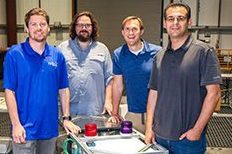The Nevada National Security Site (NNSS) was named a finalist in the 2019 R&D 100 Awards for its breakthrough Falcon Plasma Focus (FPF) device, led by NNSS Senior Engineer Brady Gall.
Dense Plasma Focus (DPF) systems create short, high-intensity neutron pulses, making them capable of detecting the presence of special nuclear material that may be hidden or inaccessible by visual inspection. However, DPF systems at the NNSS are large, stationary platforms. Developed by Gall, NNSS Technologist Joseph Bellow, Engineer Michael Heika and Master Technologist Michael Blasco, the FPF model is a compact, mobile version of the technology that can be easily transported and operated.
“With this recognition, I hope that our portable FPF technology will receive continued support to advance plasma science and nuclear physics research, create new business opportunities and, most importantly, serve our nation as a reliable non-proliferation capability,” Gall said.
The FPF represents a multi-year effort to utilize the technology for NNSS Defense Nuclear Nonproliferation missions and involves partnerships with scientists from Los Alamos National Laboratory (LANL); Sandia National Laboratories; Lawrence Livermore National Laboratory; the University of Nevada, Las Vegas; Powder River Geophysical; Alameda Applied Sciences; and Sigma Science/Keystone Global Engineering and Technology, Inc.
The R&D 100 Awards will take place Dec. 5, during the R&D 100 conference in San Francisco. The NNSS has previously won six R&D 100 awards for its 2018 Silicon Strip Cosmic Muon Detectors, 2017 Geometrically Enhanced Photocathodes, 2013 KiloPower with LANL, 2012 Multiplexed Photonic Doppler Velocimeter, 2010 Movies of eXtreme Imaging Experiments (MOXIE) with LANL and 2009 High-Resolution Holography Lens entries. NNSS was also a finalist for its Argus Fisheye Probe in 2015.

